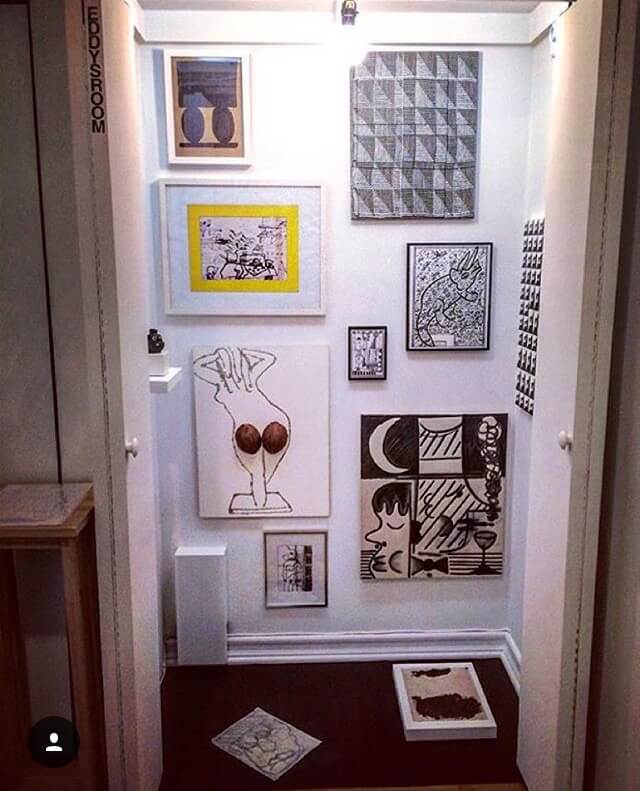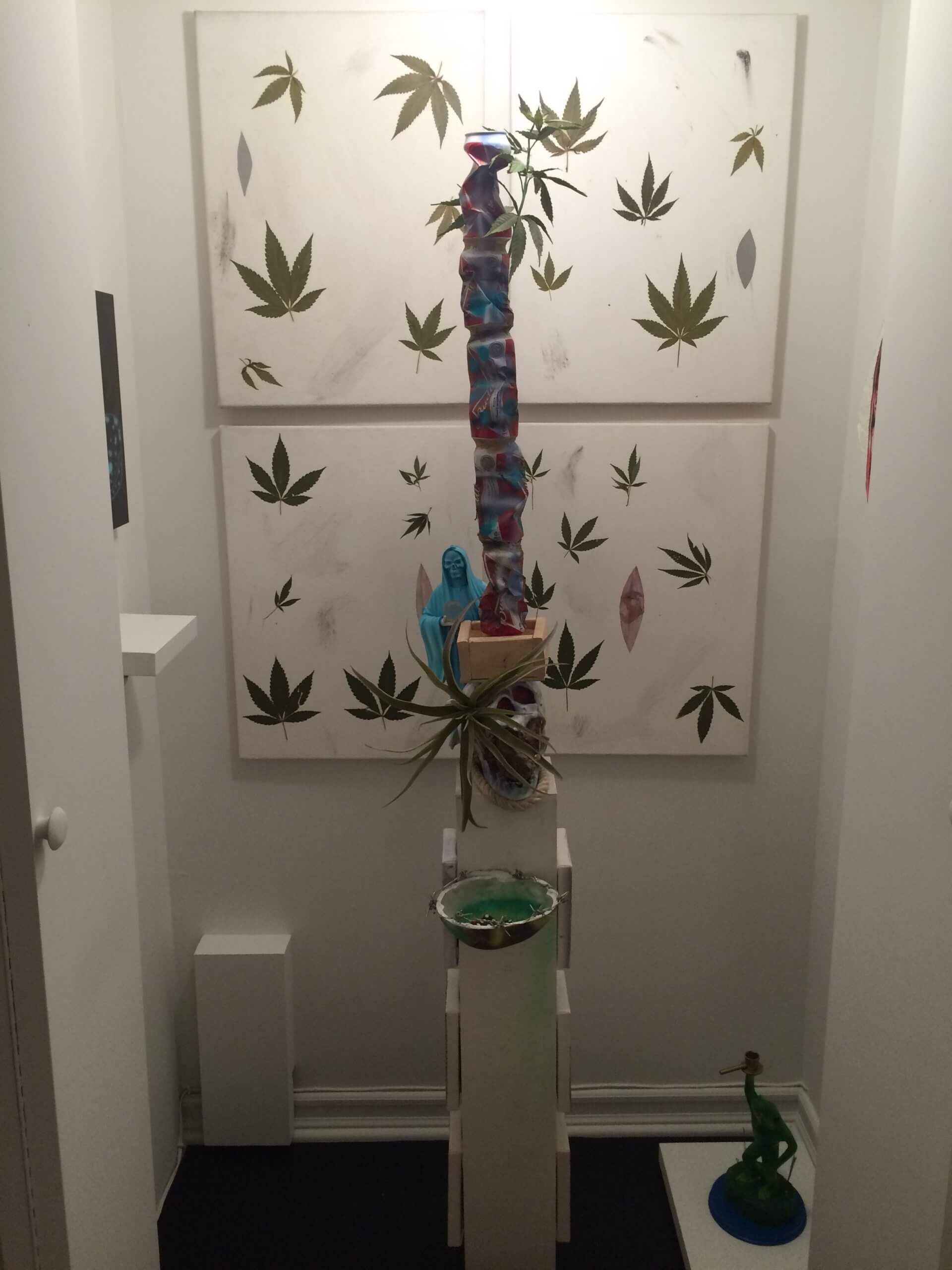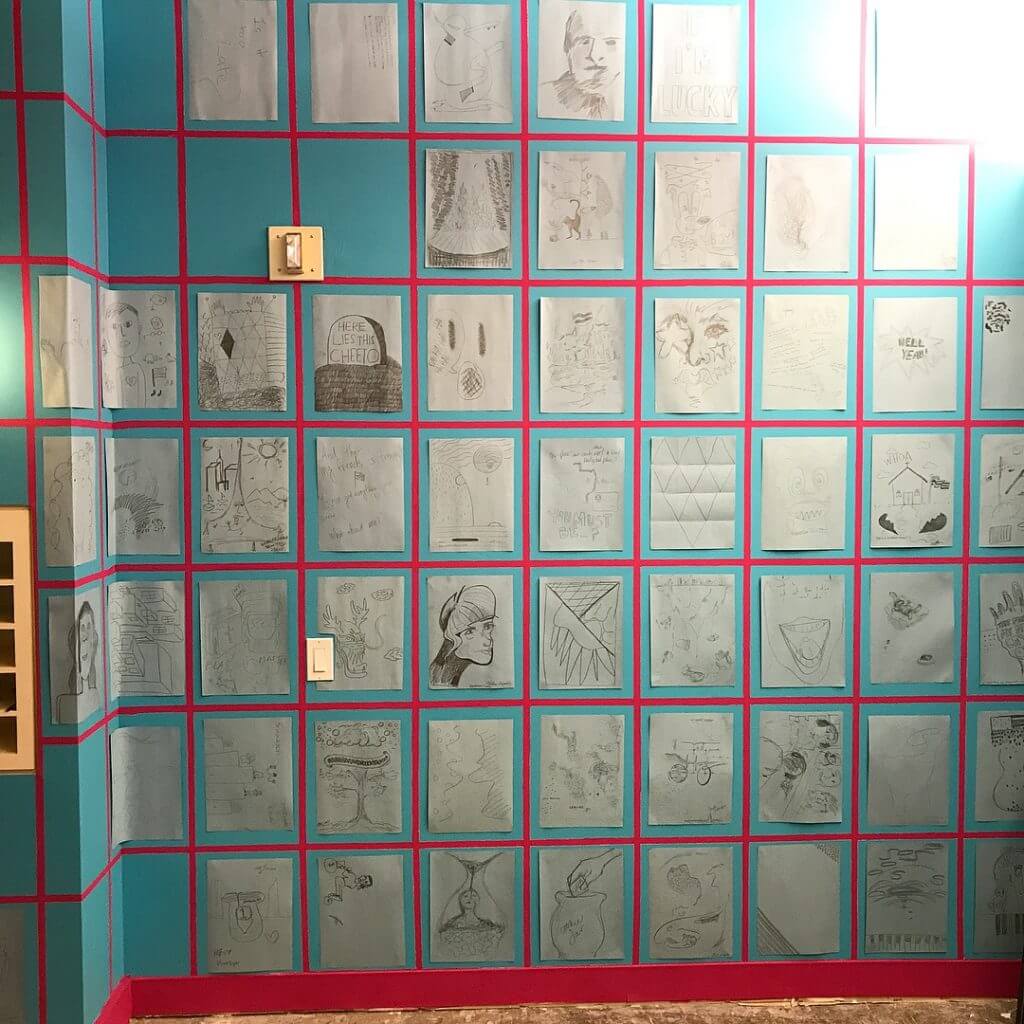EDDYSROOM: Out of the Galleries and Into The Closet


Who would have guessed that a closet in a Greenpoint apartment would be a captivating way to show cutting-edge art, as well as bring together a supportive community of artists and art viewers? But that’s exactly what artist Austin Eddy has accomplished with his own homegrown alternative space EDDYSROOM.
Since its founding in 2015, EDDYSROOM has held monthly exhibitions with semi-private, “BYOB to some degree” openings. First starting as a way for Eddy to showcase the art he traded with his friends in salon-style hung exhibitions, the gallery’s curatorial focus has since expanded. The most recent exhibition in August–EDDYSROOM’s tenth–continued Eddy’s recent pairing of paintings and sculptures with a duel show of Jeremy Roby and Johannes Vanderbeek. Despite the tight squeeze in the closet, which was quite large by New York standards, the small space somehow didn’t restrict art viewing, but illuminated the similarities between the surrealist imagery, amorphous forms and vibrant colors in Roby’s two paintings and Vanderbeek’s six-foot sculpture.

Even more than the art, EDDYSROOM seems to be about the creation of a micro arts community within the often overwhelming New York–or even, Brooklyn–arts scene. The crowd at Roby and Vanderbeek’s exhibition was friendly, open and clearly a close-knit group, making the opening feel more like a family reunion than an everyday art event. Not only a community of art lovers, EDDYSROOM provides Eddy’s artist friends and colleagues with room to play with their craft beyond the commercial galleries, which can, at times, restrict artistic experimentation.
After attending Roby and Vanderbeek’s opening, I spoke with Austin Eddy via email about the founding of EDDYSROOM, how he chooses the artists to exhibit and if he’s encountered any logistical struggles bringing sculptures into a Brooklyn walk-up.

You started EDDYSROOM a year ago. What initially inspired you to create a monthly art space in a closet of your apartment?
I think at the beginning, I was not really interested in fixing up the closet and doing shows. I expected it to become more of a storage space where I would do group shows of paintings from trades with other artists. But as things developed, the project grew on its own and sort of took the lead. Initially, the closet was empty and I was hanging and storing extra work in there for when we would switch the paintings in the house. I eventually got tired of the unfinished closet and decided one day after work, fuck it–why not fix it up? Why not start a gallery? And I just did it. It was not an uncommon thing in Chicago [where Eddy attended school] for people to have these alternative spaces and while I was in school, I always thought it would be cool to do. But I just never had the “space” or time, I guess. But, for some reason, moving here made it all strangely possible.
There are lots of reasons–not all of them are even clear to me.


You opened the 10th show at EDDYSROOM in August. Looking at the list of your previous shows, you’ve exhibited a diverse selection of artists including Katherine Bernhardt, Trudy Benson, Ryan Schneider and your own work. How do you approach choosing the artists?
At the start of things, it was people I knew and people whose work I really liked and traded with. So at the beginning, it was curating via the collection and works available in the closet. It quickly transitioned into the work of people I knew and people whose work I liked but did not own. Then, I just started asking people whose work I liked if they would like to do a show in the space. Now, it’s a mix of asking people I know, don’t know, things I own or anything in between. The gallery is open for submissions and I do get some from time to time, but they have always come while the program has been full. I am open to reviewing people’s ideas for shows and/or the work they would like to show in the space.


You had an ongoing series of pairings of sculptures and paintings this summer, including the show in August. Do these different mediums ever present practical curatorial challenges? I can’t imagine it’s easy getting a six-foot sculpture up an apartment building staircase and into a closet.
Yes, the shows this summer have been painting and sculpture pairs. They have all been really exciting shows. The first two artists were Robert Davis and Howard Fonda. For that show, Howard mailed his sculpture in and so it broke down into little parts that were then assembled in the space. Similarly, Rob had a painting that he made to fit the space and it worked perfectly. In the second pairing of Matthew Ronay and Clare Grill, Matthew made a sculpture for the space and so there was no problem getting it into the space thanks to his ingenuity. Clare had a few paintings in mind and, at the end, we decided to go with a painting that fit the entire back wall of the space. In the last show with Johannes Vanderbeek and Jeremy Roby, the works again posed little difficulty to get into the space. Previous to these groupings of artists, Richard Thomas Cowan had a large sculpture that broke down into smaller pieces, as did the sculpture of Ryan Johnson.
Oddly enough, it has been quite easy getting all the work into the space. People have been really good about planning and working with the awkwardness of it all. I guess people move fridges and couches into apartments all the time, which are usually much heavier and far more awkward to carry into hallways and up stairwells.
Curating a monthly show is a lot of work even with a small space. Do you think curating EDDYSROOM has altered your own artistic practice or your conception of how you see your work? How?
I have tried to keep the gallery separate from my artistic practice. I have found the gallery to be more of a chance to bring people together through their work and function as a social outlet for artists and art viewers.
There seems to be more and more of these apartment and/or studio shows happening, particularly in Brooklyn. Of course, New York also has a long history of artist-driven, DIY spaces. For example, Gracie Mansion started her first gallery in her bathroom. How do you see EDDYSROOM in conversation with both these contemporary DIY shows and their history?
I think it fits right where it should. I’m not sure exactly where that is, but I am enjoying it for what it is. I think it’s a good thing that so many people are making their own way and doing things they want to. It keeps the world interesting and turning.
For many of the artists involved, the space presents an opportunity for them to experiment with new work. What has the feedback been from the participating artists?
I think–and it seems like–almost everyone who has participated has had a good time. For the most part, I think they were happy to do something with someone else, which, at the end of the day, is all you can ask for.









Responses